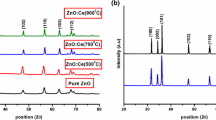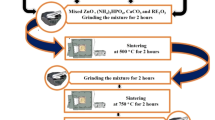Abstract
ZnO nanophosphor co-doped with Ce, Eu and Tb [Zn1−x–y–z O:CexEuyTbz (x, y and z = 0.1, 0.5, and 1.0 mol.%)] was prepared by the co-precipitation method followed by sintering in the air at 700 °C. The powder XRD spectrum could be indexed using the JCPDC File No. 36-1451 implying that the doping levels investigated in the present study did not change the basic wurtzite crystal structure of the ZnO. The absence of any independent phases of the Ce, Eu and Tb confirmed the incorporation of these dopants in the ZnO lattice. The dopants could enter the ZnO lattice interstitially or/and substitutional. The substitutional incorporation could result in the development of strain in the unit cell as the radii of all the dopants are greater than Zn. This strain could be responsible for the observed shift in the peak positions of diffraction peaks; the observed shift was ~ 0.20° (towards the lower side) for the diffraction peak with (hkl) value (101) for ZnO doped with 0.5 mol.% Ce, Eu and Tb. On the other hand, interstitial substitution could result in the creation of the defects like vacancies. These defects could create the inter-band defect states which could emit in the visible region (400–700 nm).Emission in the visible region was observed when excited with the 280,300 and 380 nm radiation from a Xe lamp; the 280 and 300 nm excitations resulted in broad emission centered around ~ 510 nm while relatively sharp emission peaks were observed with 380 nm radiation; the emission intensity was found to be dependent on the dopant concentration. The chromaticity color coordinates (x and y) of the observed broad emission were calculated using the data from the emission spectrum. The best calculated values were: x = 0.33 and y = 0.34 for ZnO co-doped with Ce 0.5, Eu 0.1 and Tb 0.1 mol.%; these “x and y” values being very close to those of the “sunlight at noon” (x = 0.33 and y = 0.33), indicate the potential of this material for the realization of the white light sources.











Similar content being viewed by others
References
Andres, J.H., Lee, R.L., Romero, J.: Calculating correlated color temperatures across the entire gamut of daylight and skylight chromaticity’s. Appl. Opt. 38, 5703–5709 (1999)
Das, D., Mondal, P.: Photoluminescence phenomena prevailing in c-axis oriented intrinsic ZnO thin films prepared by RF magnetron sputtering. RSC Adv. 4, 35735–35743 (2014)
Jin, M., Feng, J.I., Zhang, D.H., Ma, H.L., Li, S.Y.: Optical and electronic properties of transparent conducting ZnO and ZnO: Al films prepared by evaporating films. Thin Solid Films 357, 98–101 (1999)
Kalaiezhily, R.K., Saravanan, G., Asvini, V., Vijayan, V., Ravichandran, K.: Tuning violet to green emission in luminomagnetic Dy, Er co-doped ZnO nanoparticle. Ceram. Int. 44, 19560–19569 (2018)
Keller, A.A., Wang, H., Zhou, D., Lenihan, H.S., Cherr, G., Cardinale, B.J., Miller, R.: Stability and aggregation of metal oxide nanoparticles in natural aqueous matrices. Environ. Sci. Technol. 44, 1962–1967 (2010)
Kelly, K.L.: Lines of constant correlated color temperature based on MacAdam’s (u, υ) uniform chromaticity transformation of the CIE diagram. JOSA. 53, 999–1002 (1963)
Kumar, V., Ntwaeaborwa, O.M., Soga, T., Dutta, V., Swart, H.C.: Rare earth doped zinc oxide nanophosphor powder: a future material for solid state lighting and solar cells. ACS Photonics 4, 2613–2637 (2017)
Layek, A., Banerjee, S., Manna, B., Chowdhury, A.: Synthesis of rare-earth doped ZnO nanorods and their defect–dopant correlated enhanced visible-orange luminescence. RSC Adv. 6, 35892–35900 (2016)
Li, Y.C., Chang, Y.H., Lin, Y.F., Chang, Y.S., Lin, Y.J.: Synthesis and luminescent properties of Ln3+ (Eu3+, Sm3+, Dy3+)-doped lanthanum aluminum germanate LaAlGe2O7 phosphors. J. Alloys Compd. 439, 367–575 (2007)
Lin, B., Fu, Z., Jia, Y.: Green luminescent center in undoped zinc oxide films deposited on silicon substrates. Appl. Phys. Lett. 79, 943–946 (2001)
Lin, Y., Tang, Z., Zhang, Z., Nan, C.: Influence of co-doping different rare earth ions on the luminescence of CaAl2O4-based phosphors. J. Eur. Ceram. Soc. 23, 175–178 (2003)
Manzano, C. V., Alegre, D., Caballero-Calero, O., Alén, B., González, M.: Synthesis and luminescence properties of electrodeposited ZnO films. J. Appl. Phys. 110, 043538 (2011)
Mc Camy, C.S.: Correlated color temperature as an explicit function of chromaticity coordinates. COLOR Res. Appl. 17, 142–144 (1992)
Melnick, D.A.: Zinc oxide photo conduction as oxygen adsorption process. J. Chem. Phys. 26, 1136–1146 (1957)
Meulenkamp, E.A.: Size dependence of the dissolution of ZnO nanoparticles. J. Phys. Chem. B. 102, 7764–7769 (1998)
Mohanta, A.: Effect of pressure and Al doping on structural and optical properties of ZnO nano-wires synthesized by chemical vapor deposition. J. Lumin. 146, 470–474 (2014)
Motloung, S., Dejene, F.B., Ntwaeaborwa, O.M., Swart, H.C., Kroon, R.E.: Colour tuning and energy transfer pathways in MgAl2O4 triply doped with 0.1% Ce3+, 0.1% Eu 2+, x% Tb 3+ (0 ≤ x ≤ 2%) nanocrystals synthesized using sol–gel process. Chem. Phys. 487, 75–86 (2017)
Ohno, Y.: CIE Fundamentals for Color Measurements.NIP & Digital Conference, pp. 540–545 (2000)
Paraguay, F., Estrada, W., Acosta, D.R., Andrade, E., Yoshida, M.M.: Growth, structure and optical characterization of high quality ZnO thin films obtained by spray pyrolysis. Thin Sold Films. 350, 192–202 (1999)
Pearton, S.J., Norton, D.P., Ipokum, K., Heo, Y.W., Steiner, T.: Recent progress in processing and properties of ZnO. Progress Mater. Sci. 3, 293–340 (2005)
Suman Rani, S., Lal, B., Saxena, S., Shukla, S.: Investigations on the visible emission from ZnO nanophosphorco-doped with Ce, Eu and Tb. Mater. Today: Proc. 4, 9375–9379 (2017)
Ronda, C.R., Jestel, U., Nikol, H.: Rare earth phosphors: fundamentals and applications. J Alloys Compd. 275, 669–676 (1998)
Schanda, J., Danyi, J.M.: Correlated color temperature calculations in the CIE 1976 UCS diagram. Color Res. Appl. 2, 161–163 (1977)
Shin, K., Prabakar, K., Tai, W., Oh, J.H., Lee, C., Park, D.W., Ahn, W.S.: The structural and photoluminescence properties of Al:ZnO/porous silicon. J. Korean Phys. Soc. 45, 1288–1291 (2004)
Sivakami, R., Thiyagarajan, P.: Synthesis and luminescence properties of ZnS:Ce3+,Li+,Mn2+ a nanophosphors. Nano-Struct. Nano-Objects. 6, 59–66 (2016)
Studenikin, S.A., Golego, N., Cocivera, M.: Optical and electrical properties of undoped ZnO films grown by spray pyrolysis of zinc nitrate solution. J. Appl. Phys. 83, 2104–2109 (1998)
The CIE 1931 color space chromaticity diagram. https://www.ledtuning.nl/en/cie-convertor. Accessed on 21 Feb 2018
Van der Burgt, P., Van Kemenade, J.: About color rendition of light sources: the balance between simplicity and accuracy. Color Res. Appl. 35, 85–93 (2010)
Wang, Y., Zhu, G., Xin, S., Wang, Q., Li, Y., Wu, Q., Wang, C., Wang, X., Ding, X., Geng, W.: Recent development in rare earth doped phosphors for white light emitting diodes. J. Rare Earths 33, 1–12 (2015)
White, W.B., Keramidas, V.G.: Vibrational spectra of oxides with the C-type rare earth oxide structure. Spectrochim. Acta Part A. Mol. Spectrosc. 28, 501–509 (1972)
Xie, R.J., Hirosaki, N., Li, Y., Takeda, T.: Rare-earth activated nitride phosphors: synthesis, luminescence, and applications. Materials. 3, 3777–3793 (2010)
Zhang, S.B., Wei, S.H., Zunger, A.: Intrinsic n-type versus p-type doping asymmetry and the defects physics of ZnO. Phys. Rev. 63, 075205 (2001)
Zhao, J.L., Li, X.M., Bian, J.M., Yu, W.D., Gao, X.D.: Structural, optical and electrical properties of ZnO films grown by pulsed laser deposition. J. Cryst. Growth 276, 507–512 (2005)
Author information
Authors and Affiliations
Corresponding author
Additional information
Publisher's Note
Springer Nature remains neutral with regard to jurisdictional claims in published maps and institutional affiliations.
Rights and permissions
About this article
Cite this article
Rani, S., Lal, B. ZnO nanophosphor Co doped with Ce, Eu and Tb. Opt Quant Electron 52, 328 (2020). https://doi.org/10.1007/s11082-020-02440-3
Received:
Accepted:
Published:
DOI: https://doi.org/10.1007/s11082-020-02440-3




